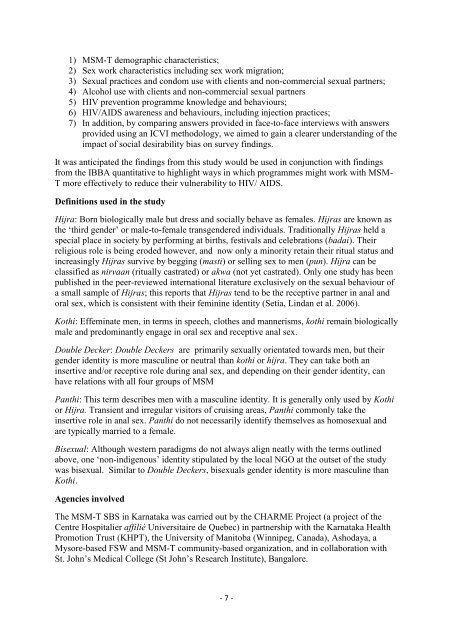sexual behaviour and hiv risk in men who - Karnataka Health ...
sexual behaviour and hiv risk in men who - Karnataka Health ...
sexual behaviour and hiv risk in men who - Karnataka Health ...
Create successful ePaper yourself
Turn your PDF publications into a flip-book with our unique Google optimized e-Paper software.
1) MSM-T demographic characteristics;2) Sex work characteristics <strong>in</strong>clud<strong>in</strong>g sex work migration;3) Sexual practices <strong>and</strong> condom use with clients <strong>and</strong> non-commercial <strong>sexual</strong> partners;4) Alcohol use with clients <strong>and</strong> non-commercial <strong>sexual</strong> partners5) HIV prevention programme knowledge <strong>and</strong> <strong>behaviour</strong>s;6) HIV/AIDS awareness <strong>and</strong> <strong>behaviour</strong>s, <strong>in</strong>clud<strong>in</strong>g <strong>in</strong>jection practices;7) In addition, by compar<strong>in</strong>g answers provided <strong>in</strong> face-to-face <strong>in</strong>terviews with answersprovided us<strong>in</strong>g an ICVI methodology, we aimed to ga<strong>in</strong> a clearer underst<strong>and</strong><strong>in</strong>g of theimpact of social desirability bias on survey f<strong>in</strong>d<strong>in</strong>gs.It was anticipated the f<strong>in</strong>d<strong>in</strong>gs from this study would be used <strong>in</strong> conjunction with f<strong>in</strong>d<strong>in</strong>gsfrom the IBBA quantitative to highlight ways <strong>in</strong> which programmes might work with MSM-T more effectively to reduce their vulnerability to HIV/ AIDS.Def<strong>in</strong>itions used <strong>in</strong> the studyHijra: Born biologically male but dress <strong>and</strong> socially behave as females. Hijras are known asthe „third gender‟ or male-to-female transgendered <strong>in</strong>dividuals. Traditionally Hijras held aspecial place <strong>in</strong> society by perform<strong>in</strong>g at births, festivals <strong>and</strong> celebrations (badai). Theirreligious role is be<strong>in</strong>g eroded however, <strong>and</strong> now only a m<strong>in</strong>ority reta<strong>in</strong> their ritual status <strong>and</strong><strong>in</strong>creas<strong>in</strong>gly Hijras survive by begg<strong>in</strong>g (masti) or sell<strong>in</strong>g sex to <strong>men</strong> (pun). Hijra can beclassified as nirvaan (ritually castrated) or akwa (not yet castrated). Only one study has beenpublished <strong>in</strong> the peer-reviewed <strong>in</strong>ternational literature exclusively on the <strong>sexual</strong> <strong>behaviour</strong> ofa small sample of Hijras; this reports that Hijras tend to be the receptive partner <strong>in</strong> anal <strong>and</strong>oral sex, which is consistent with their fem<strong>in</strong><strong>in</strong>e identity (Setia, L<strong>in</strong>dan et al. 2006).Kothi: Effem<strong>in</strong>ate <strong>men</strong>, <strong>in</strong> terms <strong>in</strong> speech, clothes <strong>and</strong> mannerisms, kothi rema<strong>in</strong> biologicallymale <strong>and</strong> predom<strong>in</strong>antly engage <strong>in</strong> oral sex <strong>and</strong> receptive anal sex.Double Decker: Double Deckers are primarily <strong>sexual</strong>ly orientated towards <strong>men</strong>, but theirgender identity is more mascul<strong>in</strong>e or neutral than kothi or hijra. They can take both an<strong>in</strong>sertive <strong>and</strong>/or receptive role dur<strong>in</strong>g anal sex, <strong>and</strong> depend<strong>in</strong>g on their gender identity, canhave relations with all four groups of MSMPanthi: This term describes <strong>men</strong> with a mascul<strong>in</strong>e identity. It is generally only used by Kothior Hijra. Transient <strong>and</strong> irregular visitors of cruis<strong>in</strong>g areas, Panthi commonly take the<strong>in</strong>sertive role <strong>in</strong> anal sex. Panthi do not necessarily identify themselves as homo<strong>sexual</strong> <strong>and</strong>are typically married to a female.Bi<strong>sexual</strong>: Although western paradigms do not always align neatly with the terms outl<strong>in</strong>edabove, one „non-<strong>in</strong>digenous‟ identity stipulated by the local NGO at the outset of the studywas bi<strong>sexual</strong>. Similar to Double Deckers, bi<strong>sexual</strong>s gender identity is more mascul<strong>in</strong>e thanKothi.Agencies <strong>in</strong>volvedThe MSM-T SBS <strong>in</strong> <strong>Karnataka</strong> was carried out by the CHARME Project (a project of theCentre Hospitalier affilié Universitaire de Quebec) <strong>in</strong> partnership with the <strong>Karnataka</strong> <strong>Health</strong>Promotion Trust (KHPT), the University of Manitoba (W<strong>in</strong>nipeg, Canada), Ashodaya, aMysore-based FSW <strong>and</strong> MSM-T community-based organization, <strong>and</strong> <strong>in</strong> collaboration withSt. John‟s Medical College (St John‟s Research Institute), Bangalore.- 7 -















